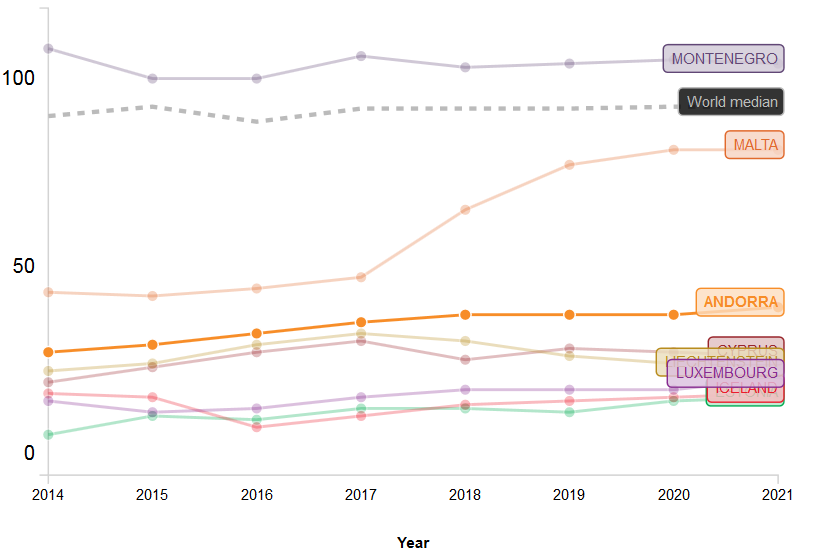Direct democracy is understood as the most binding possibility for citizens to make decisions at the ballot box that go beyond the regular elections.
Liechtenstein and San Marino have numerous instruments of direct democracy. Referendums are not only held when ordered by parliament, but also by way of popular initiatives or citizens' referendums.
Malta, Montenegro and Luxembourg are somewhat more reserved in the legal availability of direct democracy instruments as well as the frequency of referendums.
Andorra, Estonia and Iceland can hold referendums, but only if ordered by the authorities. Cyprus, on the other hand, excludes direct popular participation. This is not least due to the fact that because of the division of the island and the conflict behind it, there are concerns that this could further exacerbate social conflicts.
Direct democratic instruments
| Small State |
Popular Initiative |
Popular Referendum |
Referendum by authorities |
| Liechtenstein |
Yes |
Yes |
Yes |
| San Marino |
Yes |
Yes |
Yes |
| Malta |
Yes |
- |
Yes |
| Montenegro |
Yes |
- |
Yes |
| Luxembourg |
- |
Yes |
Yes |
| Andorra |
- |
- |
Yes |
| Estonia |
- |
- |
Yes |
| Iceland |
- |
- |
Yes |
| Cyprus |
- |
- |
- |
Andorra. Three town councils or one tenth of the people entitled to vote may submit bills to the Parliament, but no popular vote results from it.
However, the parliament can submit a bill to the people, as was last the case in 1993 with the introduction of a new constitution.
Cyprus. No direct democratic instruments such as referenda or popular initiatives are in place in Cyprus. Only a consultative referendum to seek the opinion of the people on important issues is available through the Law on referendums.
Estonia. Only the parliament has the right to initiate referendums. It can be a formulated referendum with a binding result, or a non-formulated referendum which is non-binding, but compulsory to act accordingly to the result. Amendments to the constitution have to be submitted to a referendum mandatorily.
Popular initiatives with a popular vote in the end is not in place, but 1,000 persons or more can address an appeal to the parliament for further discussion.
Iceland. Only authorities can trigger a referendum. Two issues are combined with a obligatory referendum: to remove the President from office, and to alter the constitutional status of the Church.
Liechtenstein. A wide range of direct democratic rights is enshrined in law in Liechtenstein. The most important of these are the popular initiative to amend laws or the constitution, the citizen-initiated referendum against legislative, financial or international treaty decisions by parliament, and the possibility for parliament to submit decisions to the people on its own initiative. On the other hand, the Prince also has a strong position, as he is granted a right of veto in most votes.
All these instruments are used quite often and Liechtenstein is one of the leading states in terms of the application of direct democratic rights.
Luxembourg. A citizen-initiated referendum against constitutional amendments is admitted in Luxembourg, though not used in practice. A few popular votes took place in 2012 which were submitted by the authorities.
Malta. With 10 per cent of the electorate, the number of signatures for a popular initiative is rather high. Thus, this instrument is not used very often, the last one being on spring hunting of birds in 2015. Also popular votes initiative by the government are rare.
Montenegro. The governmental and the mandatory referendum only have been applied twice: 1992 on remaining in Yugoslavia, and in 2006 the mandatory referendum in Montenegro's independence.
The hurdle to call a national referendum is rather high: at least 10 per cent of the citizens entitled to vote.
San Marino. San Marino has a broad repertoire of direct democratic rights. Indeed, these rights are also regularly applied and San Marino is one of the leading states in terms of direct democracy.
Information on the different direct democratic instruments in different countries can be found on the website Navigator to Direct Democracy. Here is the link. Popular votes in countries worldwide is documented by the Centre for Research on Direct Democracy. Here is the link.
